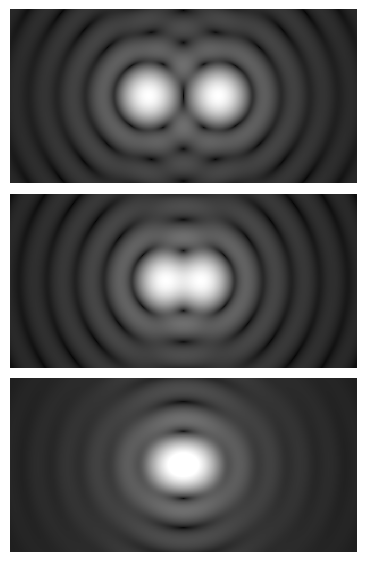Angular Resolution
Short Description of Topic
The Main Idea
Angular Resolution is the ability of a device to visibly separate two different objects in space that are located a close angular distance to each other. The closer the objects are while the device can still see distinguish between them, the higher the angular resolution is.
Angular resolution is also referred to as spatial resolution.
A Mathematical Model
The equation for angular resolution is [math]\displaystyle{ {∆θ = \frac{λ}{W}} }[/math] where W is the width of the device
A Computational Model
The top most image demonstrates the highest angular resolution. It is most able to differentiate between the two objects. The bottom image demonstrates the lowest angular resolution. It is unable to differentiate between the two objects.
Summary of Derivation
The maximum for angular momentum is the spot at which it is the brightest. The mimumum is the spot at which it is the darkest. The maximum is at angle θ while the minimum is at angle (θ + ∆θ). A minimum can only occur if light is passing through the first slit and the middle slit of width of the device. This results in a path difference of [math]\displaystyle{ {\frac{Nλ}{2}} }[/math] for the maximum [math]\displaystyle{ {\frac{Nλ}{2} + \frac{λ}{2}} }[/math] for the minimum. Through a series of trig identities, is was discovered that the angular half width of a maximum is [math]\displaystyle{ {∆θ = \frac{λ}{W}} }[/math]. This result is the definition of angular resolution.
Examples
Simple
The main application for angular resolution is in telescopes. The ability to clearly see objects in space through a telescope is mostly determined by angular resolution. The higher the resolution, the better the clarity and detail of the images.
Middling
Difficult
Another application for angular resolution is the human eye. An indication of good angular resolution is seeing crisp, clear images.
The human eye has a pupil diameter of 3mm during the day and an average optical sensitivity of 0.55um. Find the angular resolution of the average human eye during the day.
Connectedness
- How is this topic connected to something that you are interested in?
- How is it connected to your major?
- Is there an interesting industrial application?
History
Put this idea in historical context. Give the reader the Who, What, When, Where, and Why.
See also
Are there related topics or categories in this wiki resource for the curious reader to explore? How does this topic fit into that context?
Further reading
Books, Articles or other print media on this topic
External links
References
This section contains the the references you used while writing this page
